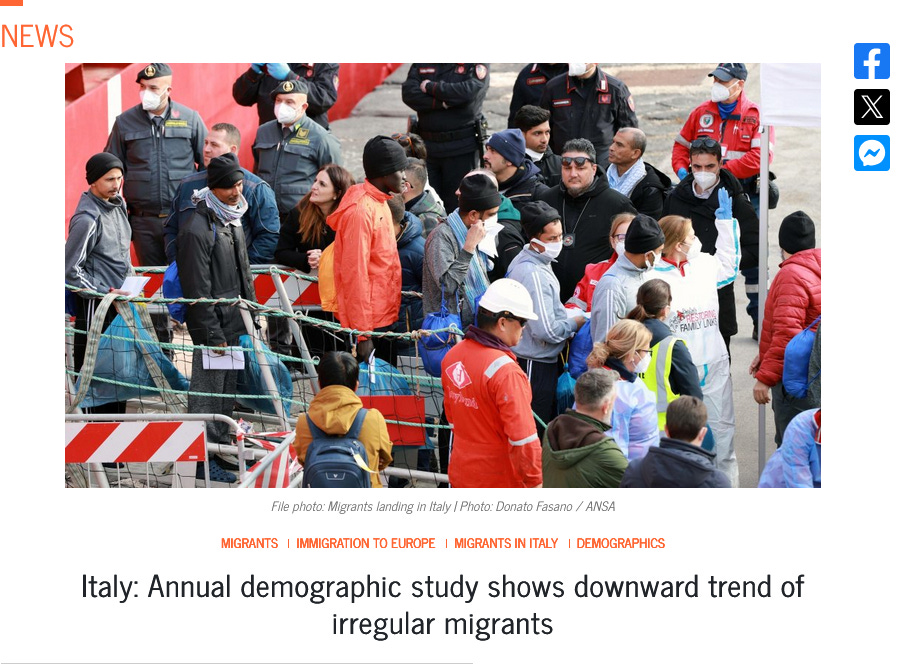A recent ISMU study for the migrant population in Italy shed some interesting light on the situation in Europe’s 5th most populated country: the number of illegal migrants has decreased and new work permits have been slashed by 42.2%. Progress has been made and there will be more on this later in the piece, but the situation remains precarious for the Italian nation.

Italy is one of the most dynamic and culturally significant Western nations, yet the Italian populace is under constant demographic, cultural, and political attack by the same neoliberal elite that plagues much of the rest of Western civilization and operates from globalist institutions such as the European Union and other captured national organisations such as the Italian courts. These anti-Western anti-Italian forces have increased their attacks against the Italian nation since the election of a moderate populist government under current and widely popular Prime Minister Giorgia Meloni.
Yet and still waves of violent migrant crime. Murders such as those of Pamela Mastropietro (killed by a Nigerian drug dealer), 16-year-old Desiree Mariottini (sexually assaulted and killed by multiple African immigrants), and the 2024 murder of Sharon Verzeni by a second generation African immigrant continue to plague the Italian people.

When the neoliberal elite of the postwar order opened the frontiers of Europe it may have been a positive vision of liberal peace and diversity in their minds, but diversity has done naught but lead to suffering. What the elite have created is a Europe whose frontiers are open to the entire world, an entire world that is relentlessly pouring into the birthplace of Western civilization and assaulting our women, children, and elderly on a daily basis.
In response the Italian people elected Giorgia Meloni – who has spoken openly about the Great Replacement and has appointed government ministers keenly aware of the ethnic replacement of Italians. Because of this Ms. Meloni and her pro-Italian government have faced numerous elite-imposed stumbling blocks on her path to reclaim Italian national sovereignty and autonomy.
The Current Demographic Situation:
Italy’s national statistics agency, the Istituto nazionale di statistica (ISTAT), does not collect data on the race and ethnicity of Italy’s population, similar to the French. As a result many of the figures we provide are a combination of related data on national origin and immigration/generational status.
The latest data from ISTAT, published January 1st of 2025, shows that 5.253 million foreign-born residents without Italian citizenship live in Italy and comprise 8.9% of the Italian population. In 2002 just 2.36% of the Italian population were non-citizen foreigners and numbered just 1.341 million individuals. Data from the European Union’s statistical agency EUROSTATE shows that 1.62 million foreigners were granted Italian citizenship between 1999 and 2020. Adding this data to the 2021 through 2023 naturalisation data provided by ISTAT shows the number of naturalised citizens in Italy to be roughly 2.17 million people. In sum, then, about 12.6% of the Italian population is of foreign birth, and this still does not paint the full picture.
There are also the Italian-born Italian citizenship holding descendants of immigrants, a population that the Italian government does not appear to keep any statistics on whatsoever. A 2022 paper by the Institute of Labor Economics indicates that the second-generation immigrant population of Italy sits at 2.5% of the population or roughly 1.475 million individuals. This sum and the previous data therefore show that the non-native population of Italy is roughly 15.1%, though this is likely a slight underestimate due to limited data on the part of ISTAT.
This puts the ethnic Italian population at roughly 85% of the national population of Italy, a collapse of some 10-points since the year 2022 when Italians were at least 95% of the national populace.
A significant portion of this non-Italian population is of European origin however. Of the 5.253 million resident foreign population in Italy some 2.407 million are of European extraction. This puts the total Western/European descended share of the Italian population at roughly 90%. Many of these European peoples can and will integrate in a generation unlike those non-European immigrants with much more alien cultures, religions, and values. The aforementioned Institute of Labor Economics study reinforces this conclusion with its highlighting of how origin plays a key role not only in second-generation integration but in the native population’s perception of immigrant integration. The European and non-European origin of immigrants and their descendants is therefore quite crucial.
Policy Options:
Decreasing the number of immigrants:
Italy has already seen some modest success in tackling the immigration issue under Giorgia Meloni. The government introduced legislation that has tightened both work permit and family reunification rules, leading to a 42.2% decline in the number of work permits being issued and requiring that migrants reside in Italy for at least two years before they can bring their spouse or parents to Italy. Why an adult would need to bring their parent to abroad is perplexing and Italy should close this loophole as well.
1. Canceling visas is crucial. Data from InfoMigrants and the ISMU study at the start of this piece shows that barely 60% of foreigners in Italy are working, this means that of the non-European foreigners in the country more than 1.2 million are not working. With an unemployment rate breaching the 6.1% mark the Italian people do not need to be competing against millions upon millions of foreigners let alone subsidising the residence of non-working foreigners.
2. Review of citizenship grants. The Italian government continually discovers mafia related visa and citizenship fraud schemes where immigrants are able to pay corrupt officials thousands of Euros to have their immigration related paperwork processed rapidly and using falsified data. One such scheme was discovered in late 2024 and another such scheme was dismantled in February of 2025. In another example, again from 2025, the Italian government began the prosecution of five individuals responsible for orchestrating fake marriages in order to obtain residency in Italy.
While it is impossible to say how many foreign residents and naturalised citizens in Italy have used this pathway the number is undoubtedly tens if not hundreds of thousands.
3. Sending asylum seekers home. Italy is home to more than 165,000 refugees according to the United Nations, with most coming from Africa, Pakistan, and Afghanistan. Most of these countries are relatively safe, unlike the war torn Ukraine or besieged Gaza. The Italian state should declare these countries safe and begin returning these refugees immediately. The Italian state does plan to build reception centers in every region to facilitate such returns, though the scale of this project is thusfar limited to just 3,000 beds.
4. Voluntary remigration and the Swedish example. Italy should follow in the footsteps of the Nordic Kingdom of Sweden and begin offering a package of money and administrative assistance for those immigrants and descendants of immigrants who wish to return to their homelands. The Swedish state is offering 32,000 Euros per individual to leave the country starting in 2026, a program that the Italians should replicate.
The Italian state is currently spending 1.7 billion Euros per annum to deal with refugee flows. Another study utilizing EU data shows that 50% of non-EU immigrants utilize the Italian welfare state compared to 43% of native Italians. European migrants are less likely (-2.3%) than native Italians to apply for welfare based assistance while non-Eu migrants are significantly more likely (+1.5%) than native Italians to apply for welfare related assistance from the Italian state.
These expenditure differences alone indicate that a program of remigration for non-Europeans while retaining European immigrants will significantly strengthen Italy’s fiscal position in the medium and long term. Allowing the non-Western population to continue to grow will continue to negatively impact the Italian public’s debt and budget obligations.
Increasing the number of Italians:
Italy has one of the largest diasporas in the world and therefore a huge trove of ethnic Italians to pull back to the homeland and reinforce its struggling demographics. More than 5.8 million Italian citizens reside abroad while some 80 million people across the world sport some share of Italian ancestry – in the United States alone some 6.63 million people claim to be entirely Italian.
A great example to follow would be that of Poland. During the 2000-2016 era Poland experienced incredible levels of emigration and brain drain as its citizens fled to wealthier European countries in pursuit of work opportunities. Today, however, Poland’s sons and daughters are returning home. Even as Poland’s overall population has begun to decrease its population of ethnic Poles has increased by more than 250,000 and the largest share of ‘migrants’ to Poland each year are not non-Western foreigners but returning Poles!
Through leveraging unique economic opportunities, such as the trade deal Meloni is attempting to negotiate with the Trump administration, and other unique benefits such as paying for relocation and returns, the Italian state could begin to entice native and ethnic Italians home.
In conclusion:
The Italians are starting from a position of relative strength. Their demographic situation is not nearly as dire as that of Germany, the United Kingdom, or the embattled United States. There is opportunity to build upon the immigration restrictions imposed by Meloni and begin the process of remigration and deportation necessary to secure an Italy for Italians well into the future.
